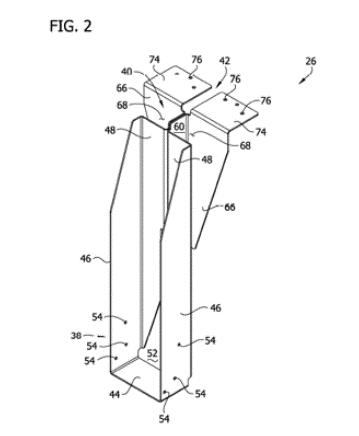The US Court of Appeals for the Federal Circuit upheld a Patent Trial & Appeal Board finding that the claims of a patent for a truss hanger were invalid for lack of written description because they claimed an undisclosed range despite the predictable nature of the technology. Columbia Insurance Company v. Simpson Strong-Tie Company Inc., Case Nos. 21-2145; -2157 (Fed. Cir. Mar. 31, 2023) (Prost, Hughes, JJ.) (Moore, C.J., dissenting) (non-precedential).
Truss hangers secure support beams to wall frames in buildings. These hangers normally accommodate layers of fire-resistant sheathing by cutting out the sheathing that overlaps with the hanger, but this can reduce fire resistance. Columbia owns a patent claiming a truss hanger that extends through the sheathing and does not decrease fire resistance. The extension for the sheathing, illustrated below, must be “sized large enough to permit two layers of ⅝ inch thick sheathing to be received between the rear edge plane and the back flange plane, but too small to permit three layers of ⅝ inch thick sheathing to be received.”

Simpson petitioned for a post-grant review of the patent at the Board. That proceeding resulted in a mixed decision. The Board found in favor of Simpson that certain original claims and certain substitute claims of the patent were unpatentable for lack of written description and that certain claims were obvious over the prior art. However, it found in favor of Columbia with regard to one claim. Both parties appealed.
The Federal Circuit affirmed the Board’s findings regarding written description. The claimed extension portion covered a range of extension sizes between the upper limit (three layers of five-eighths-inch-thick sheathing) and lower limit (two layers of five-eighths-inch-thick sheathing). The Court affirmed the Board’s finding that nothing in the specification covered the claimed upper limit. Columbia argued that a skilled artisan would read the claims to cover exactly two layers of five-eighths-inch-thick sheathing, but the Court found that this claim construction argument was forfeited because it was raised for the first time on appeal and, even if it weren’t, it was incorrect because it was akin to rewriting the claims.
The Federal Circuit also affirmed the Board’s finding that certain claims were obvious, concluding that the Board’s determination was supported by substantial evidence. The Court rejected Columbia’s argument that the Board’s claim construction violated the Administrative Procedure Act because the construction adopted by the Board was similar enough to Simpson’s proposed construction and not raised sua sponte.
Finally, the Federal Circuit affirmed the Board’s finding that the claim on which Simpson appealed was not indefinite because the term “large enough to permit the drywall to be received” informs a skilled artisan with reasonable certainty that the scope of this claim includes any extension portion sized larger than the smallest commonly known sheathing size. The Court also found that the claim was not obvious because the Board correctly interpreted the claim language [...]
Continue Reading
read more

 Subscribe
Subscribe


